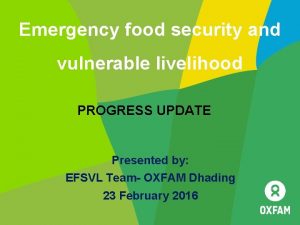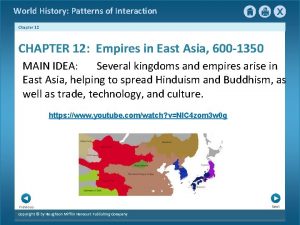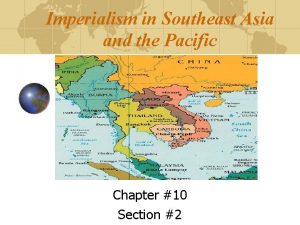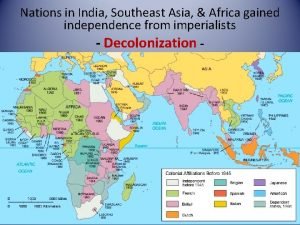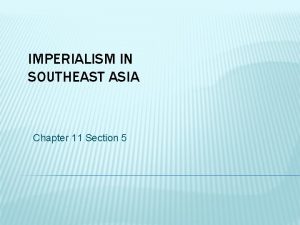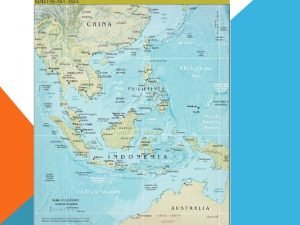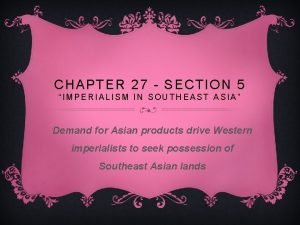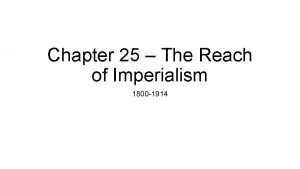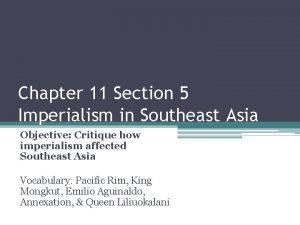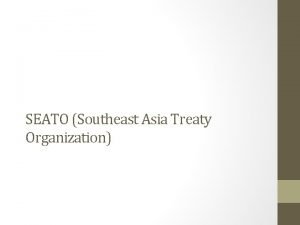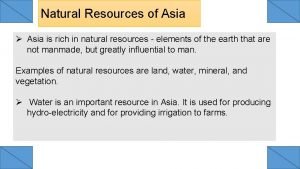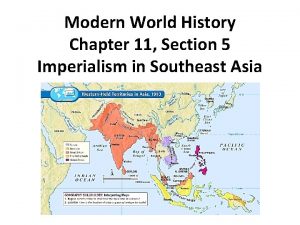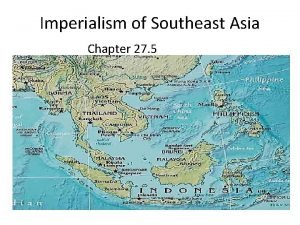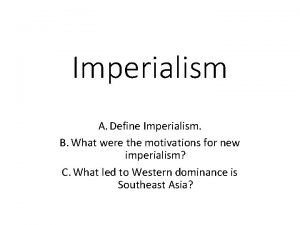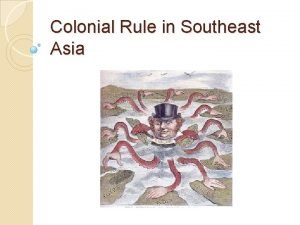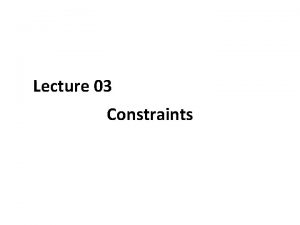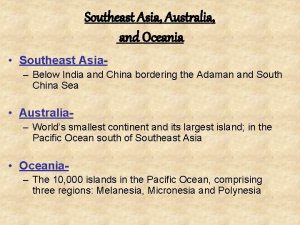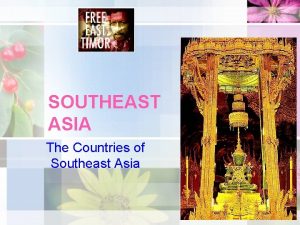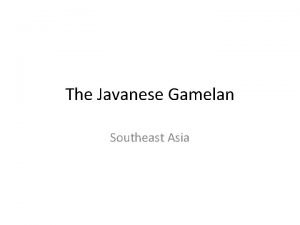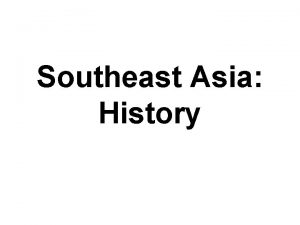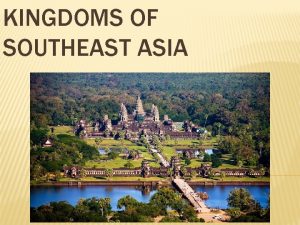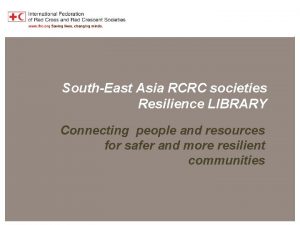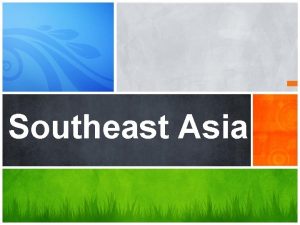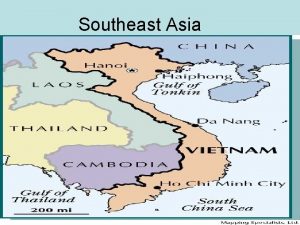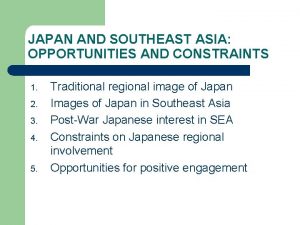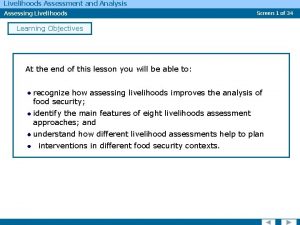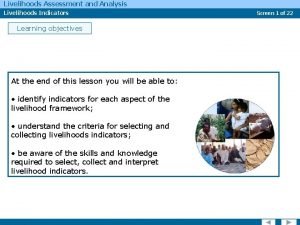Changing Rural Livelihoods in Southeast Asia Constraints and



















- Slides: 19

Changing Rural Livelihoods in Southeast Asia: Constraints and Opportunities Mokbul Morshed Ahmad, Ph. D. Associate Professor Regional and Rural Development Planning School of Environment, Resources and Development Asian Institute of Technology Thailand

Outline n n n n Poverty and Inequality Food Security Human Capital: Education Gender and Human development Globalization and its effects on the livelihoods Changes brought by ICT Vulnerability from Climate Change

Poverty in Southeast Asia Source: Asian development Bank, 2017

Poverty n n The largest reductions in poverty have been for those countries – Thailand, Malaysia and Viet Nam accomplishing the first Millennium Development Goal (MDG) Poverty incidence among ethnic minorities is the highest in the country and pace of poverty reduction slowest.

Inequality of income in South East Asia countries

Inequality of income distribution in Thailand Bangkok has the highest inequality rate while the least poverty in Thailand

Food Security n n n Majority of the countries still have more than one quarter of their children undernourished In Indonesia each 10% increase in rice price is found to reduce the spending power of the poorest tenth of the population by 2 per cent. Accurate and timely information concerning supplies of rice and other food commodities plays a vital role in ensuring food security in the region.

Global Food Security Index (GFSI) 8

GFSI, 2017 1) AFFORDABILITY Rank 1 Singapore 2 Australia 3 New Zealand 4 Japan 5 South Korea 6 Malaysia 7 Kazakhstan 8 Thailand 9 China 10 Azerbaijan 11 Vietnam 12 Sri Lanka 13 Indonesia 14 Uzbekistan 15 Pakistan 16 Cambodia 17 Philippines 18 India 19 Nepal 20 Myanmar 21 Bangladesh 22 Tajikistan 23 Laos Score / 100 91. 3 83. 8 80. 9 79. 2 71. 2 68. 1 65. 5 64. 3 63. 6 61. 1 55. 3 54. 8 50. 8 45. 5 43. 6 43. 2 42. 1 41. 1 37. 6 34. 6 30. 8 28. 2 25. 6 2) AVAILABILITY Δ +0. 1 0. 0 +0. 5 +0. 1 -0. 8 -0. 4 -1. 7 +2. 3 +0. 9 -2. 0 -0. 7 +3. 0 +0. 5 -2. 1 +0. 8 -0. 7 -1. 4 -0. 9 +1. 2 +1. 4 +1. 9 -1. 2 -1. 8 Rank 1 Japan 2 Australia 3 New Zealand 4 Singapore 5 South Korea 6 Malaysia 7 China 8 India 9 Indonesia 10 Azerbaijan 11 Sri Lanka 12 Thailand 13 Vietnam 14 Myanmar 15 Pakistan 16 Philippines 17 Bangladesh 18 Uzbekistan 19 Nepal 20 Cambodia 21 Kazakhstan 22 Tajikistan 23 Laos Score / 100 67. 3 67. 1 66. 8 65. 4 60. 4 54. 2 51. 3 48. 7 47. 2 47. 1 46. 4 45. 8 45. 7 45. 2 44. 6 43. 9 43. 2 41. 8 41. 6 39. 1 37. 0 35. 7 34. 9 3) QUALITY AND SAFETY Δ +0. 6 -0. 7 -1. 6 -1. 4 -1. 1 -3. 5 -1. 8 -2. 1 -0. 2 +1. 4 -5. 1 -1. 3 -2. 6 -1. 1 -0. 3 -1. 0 +0. 2 -1. 0 -0. 1 +1. 7 -1. 4 +0. 2 Rank Score / 100 Δ 1 Australia 81. 9 0. 0 2 New Zealand 77. 1 0. 0 3 Japan 76. 1 0. 0 4 South Korea 75. 8 -0. 3 5 Singapore 73. 1 0. 0 =6 China 66. 8 0. 0 =6 Malaysia 66. 8 0. 0 8 Thailand 55. 0 0. 0 9 Vietnam 52. 4 0. 0 =10 Kazakhstan 51. 8 0. 0 =10 Myanmar 51. 8 0. 0 12 Philippines 51. 2 0. 0 13 Sri Lanka 48. 2 +2. 0 14 India 47. 8 +2. 0 15 Nepal 46. 2 0. 0 16 Pakistan 43. 8 +2. 0 17 Indonesia 43. 1 0. 0 18 Uzbekistan 41. 0 0. 0 19 Azerbaijan 40. 1 0. 0 20 Tajikistan 36. 6 0. 0 21 Bangladesh 32. 7 +1. 8 22 Cambodia 32. 5 0. 0 23 Laos 29. 1 0. 0 http: //foodsecurityindex. eiu. com/Country 9 Nutrition, Diversification…. Rice

GREEN FIEND 53 1234 Sample Street, Anytown, St. 12345 GREENFIEND

Education n Overall quality of education in rural areas is generally poor. Drop-out rate for children and youth leaving the education system after the primary school level is very high Many school leavers fail to acquire adequate literacy or vocational/livelihood skills.

Education (contd. ) n n Net enrolment rate in secondary level in every country has increased especially in Cambodia, Indonesia, and Myanmar and the increment is over 10%. Net enrolment rate in secondary level is still low compared to primary school except in Malaysia and Thailand.

Educational inequality in Thailand ・Tuition fee(Until graduate from high school ) : free ・The other charge(uniform, stationary etc…) : free ※These expenses and textbook fee will be paid at a fixed amount for the number of students from the state to the school. • • The budget of large-scale schools ⇨ Large These large schools are concentrated in urban area such as Bangkok…. In the rural areas, they have a problem of accessibility to the school The percentage of students go to university ⇨ Urban : Rural = 7: 3 [ Inequality between Urban and Rural areas ] A Study of community and school education in northeastern Thailand, Chiaki YAMASHIRO et. al. http: //reposit. lib. kumamoto-u. ac. jp/bitstream/2298/35847/3/KKK 0065_091 -103. pdf 13

What Causes educational inequality? Thailand Japan Regional difference ①Expenditure on education out of school ② Academic expectation of parents ③Household income In Thailand, both the improvement of infrastructure in the rural areas and improving the education system including budget is needed. 14

Girl’s Education n n Without education, women enter a vicious circle marked by Fewer opportunities for employment Early marriage Poor child health care Limited knowledge of contraceptive use, and fertility.

Changes brought by ICT n n Technology is trying to bring the society closer together but the result is fragmentation of the society as the inequality becomes visible. Digital divide further creates an environment of competition for more and specialized skilled personnel thus affecting the unskilled rural people.

Vulnerability from Climate Change n Climate change causes many disasters n The worst affected group is the farmers n Shortage of land areas for agriculture due to increased aridity and associated salinity, groundwater depletion and the rise of sea level

Mekong River Delta n n 1. 77 million ha of land will be salinized, accounting for 45 percent of the land. Rise in sea level will increase salinity of main tributaries of Mekong as far inland as 10 km

 Emergency food security and vulnerable livelihoods
Emergency food security and vulnerable livelihoods Mainland se asia
Mainland se asia Chapter 12 section 5 kingdoms of southeast asia and korea
Chapter 12 section 5 kingdoms of southeast asia and korea Imperialism in southeast asia and the pacific
Imperialism in southeast asia and the pacific Southeast asian urban model
Southeast asian urban model Chapter 21 section 1 landforms and resources answer key
Chapter 21 section 1 landforms and resources answer key Is india southeast asia
Is india southeast asia Imperialism in southeast asia chapter 11 section 5
Imperialism in southeast asia chapter 11 section 5 Southeast asia climate
Southeast asia climate Chapter 27 section 5 imperialism in southeast asia
Chapter 27 section 5 imperialism in southeast asia Chapter 25 lesson 2 empire building in africa
Chapter 25 lesson 2 empire building in africa Lesson 1 physical geography of southeast asia
Lesson 1 physical geography of southeast asia Chapter 27 section 5 imperialism in southeast asia
Chapter 27 section 5 imperialism in southeast asia Southeast asian alphabets
Southeast asian alphabets Countries in southeast asia
Countries in southeast asia Natural resources of asia
Natural resources of asia Chapter 11 section 5 imperialism in southeast asia
Chapter 11 section 5 imperialism in southeast asia Chapter 27 section 5 imperialism in southeast asia
Chapter 27 section 5 imperialism in southeast asia Define imperialism
Define imperialism Colonial rule in southeast asia
Colonial rule in southeast asia
